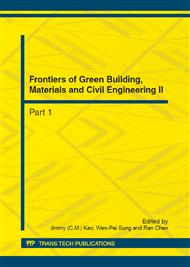p.539
p.544
p.548
p.553
p.556
p.565
p.569
p.573
p.579
Study on Evaporative Cooling Effect of Porous Decorative Layer Applied to Vertical Walls
Abstract:
The porous materials are more and more popular throughout the world. However most of the resent researches focus on the porous materials applying to horizontal plane. In this paper an experiment was conducted to study the applicability of porous decorative layer applying to vertical walls. The Experimental result shows that the wet porous decorative layer has a good applicability to west-facing wall by reducing the external surface temperature at least 8°C and eliminating the temperature peak of inner surface. The equivalent thermal resistance of the porous decorative layer is 0.40 m2•K/W, when using the 4-day value of the measurement. In the summer of Guangzhou, the porous decorative layer on west-facing wall is recommended to supply water once a day at 13:00.
Info:
Periodical:
Pages:
556-561
Citation:
Online since:
August 2012
Authors:
Price:
Сopyright:
© 2012 Trans Tech Publications Ltd. All Rights Reserved
Share:
Citation:


